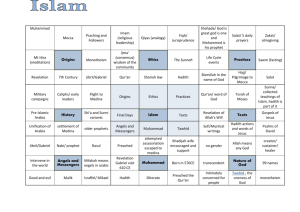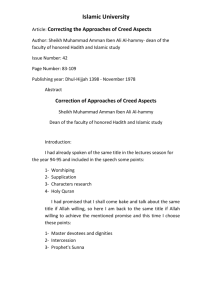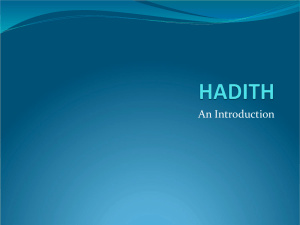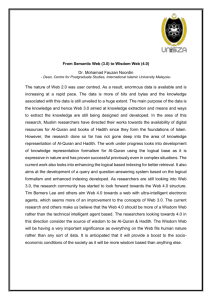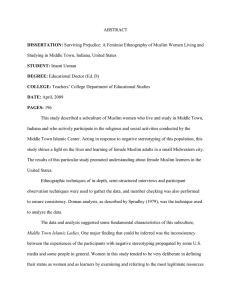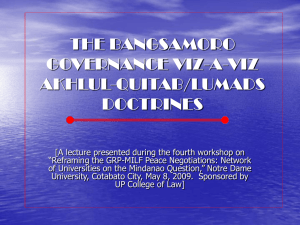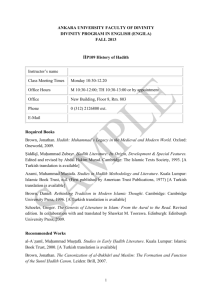Earliest Hadith Sciences Texts Written in Malay Archipelago MCSER Publishing, Rome-Italy
advertisement
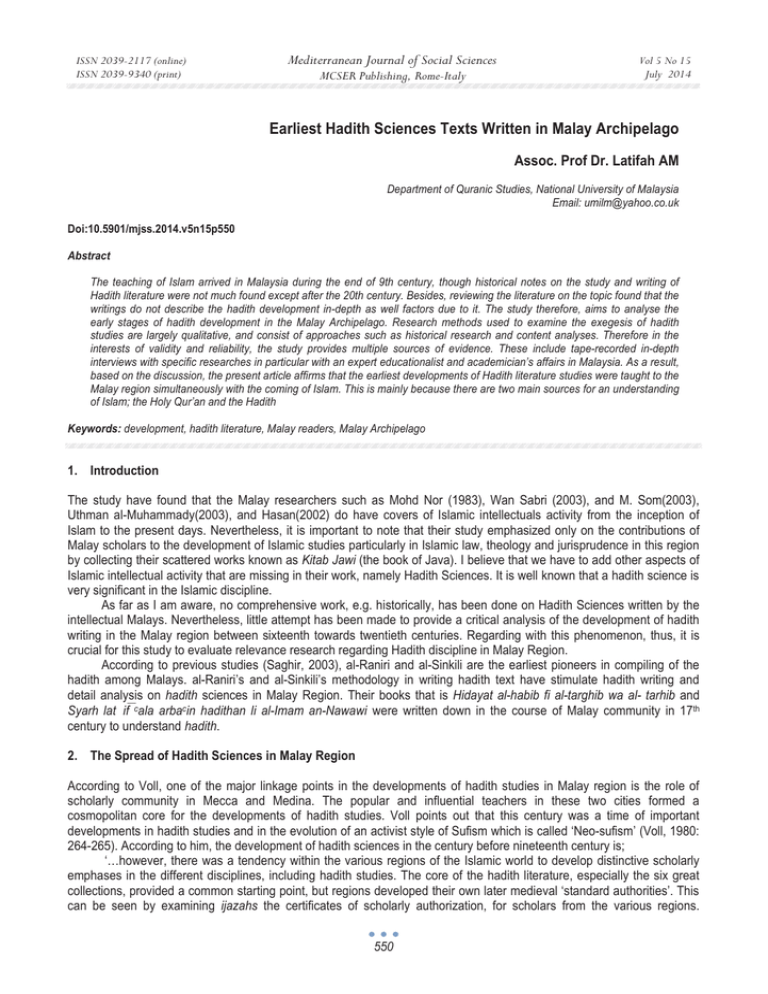
ISSN 2039-2117 (online) ISSN 2039-9340 (print) Mediterranean Journal of Social Sciences MCSER Publishing, Rome-Italy Vol 5 No 15 July 2014 Earliest Hadith Sciences Texts Written in Malay Archipelago Assoc. Prof Dr. Latifah AM Department of Quranic Studies, National University of Malaysia Email: umilm@yahoo.co.uk Doi:10.5901/mjss.2014.v5n15p550 Abstract The teaching of Islam arrived in Malaysia during the end of 9th century, though historical notes on the study and writing of Hadith literature were not much found except after the 20th century. Besides, reviewing the literature on the topic found that the writings do not describe the hadith development in-depth as well factors due to it. The study therefore, aims to analyse the early stages of hadith development in the Malay Archipelago. Research methods used to examine the exegesis of hadith studies are largely qualitative, and consist of approaches such as historical research and content analyses. Therefore in the interests of validity and reliability, the study provides multiple sources of evidence. These include tape-recorded in-depth interviews with specific researches in particular with an expert educationalist and academician’s affairs in Malaysia. As a result, based on the discussion, the present article affirms that the earliest developments of Hadith literature studies were taught to the Malay region simultaneously with the coming of Islam. This is mainly because there are two main sources for an understanding of Islam; the Holy Qur’an and the Hadith Keywords: development, hadith literature, Malay readers, Malay Archipelago 1. Introduction The study have found that the Malay researchers such as Mohd Nor (1983), Wan Sabri (2003), and M. Som(2003), Uthman al-Muhammady(2003), and Hasan(2002) do have covers of Islamic intellectuals activity from the inception of Islam to the present days. Nevertheless, it is important to note that their study emphasized only on the contributions of Malay scholars to the development of Islamic studies particularly in Islamic law, theology and jurisprudence in this region by collecting their scattered works known as Kitab Jawi (the book of Java). I believe that we have to add other aspects of Islamic intellectual activity that are missing in their work, namely Hadith Sciences. It is well known that a hadith science is very significant in the Islamic discipline. As far as I am aware, no comprehensive work, e.g. historically, has been done on Hadith Sciences written by the intellectual Malays. Nevertheless, little attempt has been made to provide a critical analysis of the development of hadith writing in the Malay region between sixteenth towards twentieth centuries. Regarding with this phenomenon, thus, it is crucial for this study to evaluate relevance research regarding Hadith discipline in Malay Region. According to previous studies (Saghir, 2003), al-Raniri and al-Sinkili are the earliest pioneers in compiling of the hadith among Malays. al-Raniri’s and al-Sinkili’s methodology in writing hadith text have stimulate hadith writing and detail analysis on hadith sciences in Malay Region. Their books that is Hidayat al-habib fi al-targhib wa al- tarhib and Syarh lat⎯if cala arbacin hadithan li al-Imam an-Nawawi were written down in the course of Malay community in 17th century to understand hadith. 2. The Spread of Hadith Sciences in Malay Region According to Voll, one of the major linkage points in the developments of hadith studies in Malay region is the role of scholarly community in Mecca and Medina. The popular and influential teachers in these two cities formed a cosmopolitan core for the developments of hadith studies. Voll points out that this century was a time of important developments in hadith studies and in the evolution of an activist style of Sufism which is called ‘Neo-sufism’ (Voll, 1980: 264-265). According to him, the development of hadith sciences in the century before nineteenth century is; ‘…however, there was a tendency within the various regions of the Islamic world to develop distinctive scholarly emphases in the different disciplines, including hadith studies. The core of the hadith literature, especially the six great collections, provided a common starting point, but regions developed their own later medieval ‘standard authorities’. This can be seen by examining ijazahs the certificates of scholarly authorization, for scholars from the various regions. 550 ISSN 2039-2117 (online) ISSN 2039-9340 (print) Mediterranean Journal of Social Sciences MCSER Publishing, Rome-Italy Vol 5 No 15 July 2014 Regionally distinctive lines of transmission of the basic hadith literature are common’. 3. Brief Background of Al-Raniri Al-Raniri real name is Nur al-Din Muhammad ibn Ali ibn Hasanji al-Hamid (or al-Humayd) al-Shafi ciy al-Ash cari alAydarusi. Al-Raniri was born in Ranir (modern Randir) an old harbor on the Gujarat coast (al Attas, 1966:22). His father is a Hadrami immigrant with a long tradition of migrating to South and South East Asia but his mother was Malay. Al-Raniri acquired his early education in Ranir, and later continued his study with the prominent scholars in the Hadramawt region (Azra, 2004: 56-62). Among al-Raniri’s well-known teacher was Abu Hafs cUmar ibn cAbd Allah Ba Shayban al-Tarimi al-Hadrami (d.1066/1656), which was initiated him into the Rifaciyyah order, an old Arab tariqah (Trimingham, 1971:37-40). Ba Shayban was appointed al-Raniri his khalifah of the tariqah and was therefore responsible for spreading it in the Malay region (Aboebakar,1979:95-98). However, the Rifaciyyah was not the only order al-Raniri was affiliated with. He also had chains of initiation of the Aydarusiyyah and Qadiriyyah orders. Ba Shayban had studied in Arabia, but later settled in India where he was initiated into the Rifaciyyah order by Sayyid Muhammad ibn cAbd Allah alAydarus at Surat. Among the important scholars in Tarim where he studied with for instance cAbd Allah ibn Shaykh alAydarus, a disciple of Ahmad al-Qushahi who also al-Sinkili’s a teacher, and cAbd al-Aziz al-Zamzami his son, Zayn alcAbidin; Qadi cAbd al-Rahman bin Shihab al-Din al-Saqqaf (945-1014/1538-1605), and Abu Bakr ibn Shihab (d. 1061/1651). According to Azra (2004:173), al-Muhibbi pointed out that Abu Bakr al-Shihab was a great traditionist (almuhaddith al-kabir), had studied in the Yemen and the Haramayn (Mecca and Medina) before establishing his carrier in Tarim. Al-Raniri largely involve in spreading hadith knowledge amongst local people in this period with compiling a hadith text into Malay language. Azra (2004:54) said, al-Raniri’s work is the pioneer in the field of Islamic intellectual thought in the Malay region. Al- Raniri was a prolific and knowledgeable writer. According to various sources he wrote no fewer than 29 works. His works mainly deal with tasawwuf, kalam, fiqh, hadith, history and comparative religion. Most of al-Raniri works are always makes good use of standard books and leading authorities. He was certainly an enthusiastic reader. On kalam and tasawwuf he quotes from al-Ghazali, Ibn cArabi, al-Qunyawi, al-Qashani, al-Firuzabadi, Abd al-Rahman al- Jami and other leading scholars.As for his fiqh he based himself on the standard Shafii books, including Hidayat al- Muhtaj Sharh al-Mukhtasar of Ibn Hajar, Minhaj al-Talibin of al-Nawawi, and Fath al-Wahhab bi sharh Minhaj al-Tullab of Zakariya alAnsari. Considering al-Raniri’s work and their sources, it is clear that he was a zealous man as Syaikh al-Islam and he was a primarily sufi, theologian and a faqih. As far as of hadith sciences work is concern, the spectacular work of alRaniri’s works is Hidayat al-Habib fi al-Targhib wa al- Tarhib which I will discuss later Al-Raniri has claim that Islam in Malay region had been corrupted by misunderstanding of the Sufi doctrine. Therefore, al-Raniri has been spending much of his energy in refuting the doctrine of wahdat al-wujud.. In order to refute the wujudiyyah in their erroneous interpretation, al-Raniri had written a short treatise entitled Shifa’ al-qulub. Nevertheless, all his works on the subject are mainly devoted to refuting Hamzah al-Fansuri and Shams al-Din alSumatrani. However, this study is not going to describe in detail of this doctrine and the controversies between Hamzah al-Fansuri and al-Raniri. According to Azra (2004:54), al-Raniri’s work is the pioneer in the field of Islamic intellectual thought in the Malay region. 4. Brief Background of Al-Sinkili cAbd al-Ra’uf ibn Ali al-Jawi al-Fansuri al-Sinkili as his name indicates, was a Malay of Fansur, Sinkil (modern Singkel), on the south-western coastal region of Aceh. In 1052/1642 al-Sinkili possibly left Aceh for knowledge activities and also has spent 19 years in Middle East. He studied in a number of places in the Middle East, which along the hajj routes such as Doha, Yemen, Jeddah, Mecca and Medina and Egypt. He mentioned that he learned from 19 teachers in various branches of Islamic discipline, and also stated 27 of other scholars he had personal contacts and relations. Among alSinkili’s teachers and most prominent of the studies of hadith sciences are Shaykh Ibrahim Ibn Abd Allah Ibn Ja’man, Ali ibn Muhammad al-Dayba’ and Shaykh Ibrahim al-Kurani. This study will discuss briefly only the most prominent among them in hadith sciences. In addition this research does not going to give accounts of all his teachers in Islamic sciences. In Yemen al-Sinkili studied and established relations mostly with scholars of Ja’aman family for example Shaykh Ibrahim Ibn Abd Allah Ibn Ja’man, Bayt al Faqih (Ibn ‘Ujail) (1083/1672), mostly known as a Muhaddith and faqih in Bayt al-Faqih. He was a prolific author of fatwas and therefore, one of the greatest scholars in the area, and al-Tayyib ibn Abi al-Qaim ibn Ja’man. Ishaq Ibn Muhammad ibn Ja’man was another major scholar in Yemen with whom al-Sinkili studied. 551 ISSN 2039-2117 (online) ISSN 2039-9340 (print) Mediterranean Journal of Social Sciences MCSER Publishing, Rome-Italy Vol 5 No 15 July 2014 Al-Sinkili also studied with Ali ibn Muhammad al-Dayba’, in Zabid, Yemen. Al-Dayba’ was a muhaddith who had closed relationships with the Tabari family and other Mecca and Medina scholars (al Kattani, 1982:587). He also became a student of Shaykh Amin Siddiq al-Mizjaji in Zabid. Al-Sinkili’s studied in Jeddah with Shaykh Abd al- Qadir al-Barkhali, Mufti of Jeddah. He also travels to Mecca and learned with great teachers in hadith studies, e.g. Shaykh Ali ibn Abd al-Qadir al-Tabary (d.1070/1660) and Shaykh Badr al-Din al-Lahuri and Abd Allah al-Lahuri. While in Medina al-Sinkili studied with prominent scholars in hadith sciences such as Shaykh Ahmad al-Qushashi (1071/1661) and Shaykh Ibrahim al-Kurani (al-Hamawi, 1982:21-32) (d.1101/16900), and Shaykh Abd Allah ibn Sa’d Allah al-Lahuri (d. in Medina in 1083/1673). He indeed learned the ‘interior’ sciences; that is tasawwuf and other related sciences with al-Qushashi. There is no doubt that al-Kurani was a great scholar in hadith studies in Medina and disciple of al-Qushashi. Azra indicates (2004:18) that al-Muradi calls him ‘a mountain among mountains of ilm and a sea among seas of ‘irfan (spiritual knowledge). Indian muhaddith Abi Tayyib Muhammad Shams al-Haq al-‘Azimabadi (b.1857), noted al-Kurani as the reformer (mujaddid) of seventeenth century. According to al-Kattani, al-Kurani was one of the scholars most responsible in Islamic history for spreading the science of hadith studies, hadith narration and its isnads in the Muslim world. In addition he was a Shaykh al-Islam and a teacher of the scholarly world, who was a ‘proof Sufism’ (hujjah al-sufiyyah) and a reviver of the Sunni mystical tradition (al-Kattani:494). Azra noted: ‘Despite his growing fascination with Sufism, Ibrahim al-Kurani did not put aside his genuine interest in hadith. For that reason he travelled to Egypt in 1061/1650, where he studied hadith its great muhaddiths, such as Muhammad ‘Ala’ alDin Shams al-Din al-Babili al-Qahiri al-Azhari (1000-1077/1592-1666), Ahmad Shihab al-Din al-Khafaji al-Hanafi alMasri (d.1069/1659), and Shaykh Sultan Ahmad ibn Salamah ibn Isma’il al-Mazzahi al-Qahiri al-Azhari (987-1075/15771644)….these scholars issued him ijazahs to teach hadith. Now I will turn our focus to the real study which is analyzing the methodology of hadith text by early Malay scholars. Specifically I examine al-Raniri’s and al-Sinkili’s methodology in writing hadith text which has stimulating hadith writing and detail analysis on hadith sciences in Malay Region. In this, investigation on methodology of hadith text writing means representing how they structure their work and how they disseminate hadith to Malay community. Accordingly, certain particular aspect of the methodology of Malay’s hadith text writing will be illustrated. This includes examination on al-Raniri and al-Sinkili’s method in writing chapters’ heading, the contents and features of the books and the concept of ‘muqaddimah’ (introduction) in those texts as an interpretation of the structure of their works. 5. Analysis of Hadith Texts: Significant Findings 5.1 The contents of Hidayat al-Habib fi al-Targhib wa al- Tarhib by al-Raniri In the mid seventeen century, in realising the need of this kind of text (and at the same time highly aware that Arabic language was hard for the Malays in general to understand), al- Raniri purposely prepared his Malay translation which he entitled Hidayat al-Habib fi al-Targhib wa al- Tarhib. By writing Hidayat al-Habib fi al-Targhib wa al- Tarhib, Al-Raniri’s not only introducing the importance of hadith in the life of Muslims, but also compiled numerous particular hadith of the Prophet s.a.w which he translated from Arabic into Malay language. Each chapter were entitled by a specific heading which clearly associated with its contents. He was the first Malay who wrote a book of hadith compilation in the Malay region. Accordingly, the Muslim population in Malay region would be able to understand them correctly. In this concise compendium, al-Raniri interpolates hadith with citations of the Qur’anic verses in order to support the arguments attached to the hadith. Because of the application of the sharicah could not be intensified without a deeper knowledge of the hadith of the Prophet s.a.w therefore, he compiled in his Hidayat al-Habib some hadith of the Prophet s.a.w. This work contains 831 hadith which include in 46 chapters in Arabic and translate into Malay. It was written in Pahang in 1635 and brought to Acheh. One of the manuscript were belongs to PNM (National Library of Malaysia), Malaysia and class number MS 1042. More importantly, a hundred years later, this work was printed by Shaykh Ahmad ibn Muhammad Zain al-Fatani commonly known as al-Fawa’idul bahiyah fi al- ahadithin nabawiyyah and appeared on the margin of the great book Hassyiyah Jam cul Fawaid of Shaykh Dawud al-Fatani. Although, it is not an exhaustive work in the subject but it provided a set of guidelines on methods of reconciliation and preference of hadith in Malay region. The fact, that the Hidayat al- 552 ISSN 2039-2117 (online) ISSN 2039-9340 (print) Mediterranean Journal of Social Sciences MCSER Publishing, Rome-Italy Vol 5 No 15 July 2014 habib was published by later scholars reflects the importance of the work as well as the intellectual stature of al-Raniri. However, it should be stressed here that the Hidayat al-habib is no longer used in the archipelago today, though it was widely circulate in the past. It is believe because of the young generation does not fully understand the writing script and the classical language as well 5.2 The contents of Syarh latif cala arbacin hadithan li al-Imam an-Nawawi of al-Sinkili Al-Sinkili concerns that there were some Malays who cannot understand Arabic fluently. On this time in the Malay region almost of hadith sciences were written in Arabic language by many scholars from Middle east; for example Sahih alBukhary of al-Bukhary, Sahih Muslim of Muslim and others. In order to attract them to learn and to understand hadith accurately, thus he came up with a commentary’s work which used Malay (Sumatra) language instead of Arabic for its Malay explanation. In the introduction, he brings up his intention on work (al-Sinkili: MS 1314:204): ‘..Dan telah ku jadikan ia dengan bahasa Jawi Pasai, pada hal aku memudahkan atas orang yang mempunyai bahasa bagi memahamkan segala makna hadith itu. ‘..And I wrote in the Sumatran Malay language because the people who using the Malay language should be understood the hadith precisely’... This is a major work of al-Sinkili in science of hadith and it was written on the request of Sultanah Safiyyat al-Din. It was completed on Tuesday in Safar 1091H/1680. The Syarh latif cala arbacin hadithan li al-Imam al-Nawawi; is the commentary on the Arba cun Hadith of al-Nawawi. It deals with cibadat (devotional services) including the iman, ihsan and others. Covering so many topics, it is a substantial work in the field. It is the first Malay translation Forty Hadith of Imam al-Nawawi in the Malay region. Furthermore, it was presented in tasawwuf teaching. This is a collection of hadith concerning the basic and practical duties of Muslims. Al-Sinkili was the first scholar in the Malay region who wrote on the forty hadith of Nawawi. By way of the Syarh latif cala arbacin he shows his fellow Muslim that hadith sciences are not confine to purely hadith literature but also include hadith criticism discipline as well. As he pointed; setelah itu maka kemudian daripada mengarang hadith empat puluh ini keadaannya sahih ertinya tiada daif maka masuklah dalamnya hasan, bermula yang kebanyakan dalam dua buah hadith iaitu sahih al-Bukhari dan sahih Muslim dan ku sebutkan ia ‘mahzuf’ segala isnad insyaAllah ta’ala supaya mudah menghafazkan dia dan lengkap beroleh manfaat dengan dia insyaAllah ta’ala Now then, as I had written the forty hadith were sahih and hasan which are derived from Sahih of al-Bukhary and Sahih of Muslim and I was abbreviating the isnad because it should be easier for people to memorize it. One can hardly overestimate the role of the Syarh latif cala arbacin in the history of science of hadith in the archipelago. Saghir revealed that ‘it is more than one way a landmark in the history of hadith learning in Malay’. It has a contributed significantly to the study of hadith in the archipelago. It lays the foundation for a bridge between translation and hadith, and thus stimulates further study on the hadith works in Arabic. In addition, Syarh latif cala arbacin was a small collection of hadith and was considered as contributing little to the development of the hadith discipline, it is masterly and clearly of the hadith. With his methodology writing, the Syarh is a good introductory text for learner in the science of hadith among the Malay Muslims. In rendering the Syarh into Malay, al-Sinkili makes it simple or comprehensible to his fellow Malays in general. Furthermore, he leaves out the isnad and extensive commentaries that might distract the attention of his audience. Thus, it is clear that his intention is that the Syarh should be easily understood by his readers and as a consequence become a practical guide for life. Having discussed al-Sinkili’s work, it is clear that he transmitted the doctrines and tendencies in the scholarly networks in order to renew the Islamic tradition in the Malay region. Al-Sinkili expresses his Sufi doctrine through his work. Thus, we have found the Sufi’s term such as Ruh Muhammad (the Light of Muhammad) Jawhar and zarrah, Nur, Aqal, Qalam , Malak Kurubiyi and others. Above of all he explained the words meaning. Regarding to his Sufi doctrine on his text thus it should be demonstrates here about his position in this region on this period. According to Azra, al-Sinkili established tariqah Shatariyyah in Malay region after returning from intellectual’s activities. Al-Sinkili became one of the most venerated personalities of the queen of Aceh on that time (Sultanah Ghinayah Syah Safiyyat al-Din Syah(1678-1688). In his entire career in Aceh, al-Sinkili was patronized by the queen of Aceh. It is at this historical juncture that al-Sinkili comes into prominence both in official and private capacity. 553 ISSN 2039-2117 (online) ISSN 2039-9340 (print) Mediterranean Journal of Social Sciences MCSER Publishing, Rome-Italy Vol 5 No 15 July 2014 However, his Sufi teachings were against by the wujudiyyah doctrines group. The Queen, who agreed with tariqah Shattariyyah had approached al-Sinkili to attacked wujudiyyah teaching. He was appointed by the Sultanah to the office of the Qadhi Malik al-Adil or Mufti who was responsible for administering religious affairs. Sultanah Safiyyat al-Din requested al-Sinkili to help her in the crisis between their Sufi tariqah (Shattariyyah) with the other Malay scholars groups for instance Syeikh Abd al-Wahab founder of Dayah in Tiro and the group of wujudiyyah doctrines (Abd Rahman, 1990:129). Thus, al-Sinkili composed this commentary of hadith sciences to support their tariqah Sufi. Clearly, this is historical evidence to support the observation that the syarh was produce in compliance with Sultanah Safiyyat request. In addition there was also the fact that such event had occurred in 2nd century of Hijri in Medina. The compilation of Muwatta’ was requested by the ruler of the kingdom. Imam Malik ibn Anas compiled a Muwatta’ on requested by Abu Ja’far al-Mansur, the second Abbasid Caliph. On that time, Abu Ja’far al-Mansur was in need of a book which could help him to remove the contradictory juridical decisions on which current practice was based. He asked Malik to put down in writing the scattered legal material in Medina and compile in one book. The Abbasids were in desperate need of some middle-path which would put an end to legal divergences and the Muwatta’ of Malik was intended to meet the situation. It is very difficult indeed to determine the exact date of the compilation of the Muwatta (Guraya:360). As he revealed in introduction; Dan adalah yang dimikian itu dengan titah hadrat Sultan yang telah dipilih Allah Ta’ala akan dia bagi berbaik segala pekerjaan dunia dan agama. Dan iaitu peghulu kita dan yang menumpukan pekerjaan kita Sultan Islam dan negeri segala orang yang Muslim yang kalian sifat sabar dan kemurahan dan yakin Paduka Sri Sultanah Ghinayah Shah Zakiyah al-Din Shah berdaulat zillullah fil alam. And by royal command from queen which was chosen by Allah s.w.t as our leader to guide us in our practical and religion matters as well. And she is our ruler and Islamic Sultanah in Muslim country is they have a characteristic in patient and believe with Paduka Sri Sultanah Ghinayah Shah Zakiyah al-Din Shah a ‘shadow of Allah upon the earth’. Thus, according to al-Sinkili’s view, the Sultan by considering him is a ‘shadow of Allah upon the earth’. Disobedience is only permissible in the event of the ruler’s decisions being manifestly contrary to the Qur’an and the Hadith. According to Malay scholars the installation of the sultan or king is fard kifaya; the election of the king is valid only if it is conducted by qualified persons; al-Sinkili probably accepted the rule of a woman and it show his personal tolerance, a trait al-Sinkili certainly possessed. The other two manuscript of Syarh latif cala arbacin hadithan li al-Imam an-Nawawi; belongs to Malay Manuscript Centre of National Library of Malaysia or Pusat Manuskrip Melayu Perpustakaan Negara Malaysia., (PNM), MS1314, and Folio 204-339 which contains 135 pages in manuscript and microfilm form. This work produced in hand writing in Jawi script by using classical Malay language and was completed in 1680. The reader will find it quite difficult with the pages system and the manuscript never published (Saghir, 1999:22). However, the first manuscript has been transliteration by Saghir. But the works not finished because of the missing pages and uncompleted manuscript. 5.3 The contents of al-Mawaciz al-Badicah of al-Sinkili The significance of al-Sinkili to the development of Islam in archipelago is irrefutable in the field of emphasizing the importance of the hadith. In fact, not only had he established the Syarh latif ala arba’in hadiht li al-imam an-Nawawi, he also wrote al-Mawaiz al-Badi’ah, a collection of hadith qudsi. Hadith qudsi is defined as the Divine communication whose revelation is not the part of the Qur’anic miracle. Hadith Qudsi is from Allah, the Most Exalted, from the point of view of meaning, and from the Prophet (s.a.w) from the viewpoint of actual wording. It constitutes what Allah has communicated to the Prophet through revelation or in dreams. The Prophet (s.a.w) informed others of its meaning in his own words. Accordingly, the Qur’an superior to the hadith qudsi, because it is actual Word of Allah (Tohan, 1987:127). Al-Sinkili was the great scholar ever in this part of the Muslim world to take on the enormous task of preparing hadith qudsi in Malay translation. Furthermore, al-Sinkili’s selection of these works reflects his genuine concern for his fellow Muslims at the grassroots level; all he wants is to lead them to a better understanding of the teaching of Islam. As he thought: pada hal aku memudahkan atas orang yang mempunyai bahasa bagi memahamkan segala makna hadith itu I composed this book in order to assist learners understanding upon hadith’ Al-Sinkili’s collection of the hadith qudsi defines with fifty teachings concerning Allah and His relation to creation, hell and paradise, and the proper ways for the individual to achieve Allah’s favor. Above of all, al-Sinkili mainly highlights 554 ISSN 2039-2117 (online) ISSN 2039-9340 (print) Mediterranean Journal of Social Sciences MCSER Publishing, Rome-Italy Vol 5 No 15 July 2014 the need for each Muslim to find harmony between knowledge (cilm) and good deeds (camal). This is because a better Muslim not only had knowledge alone but he must do good deeds as well. He thus appeals to Muslim activism. The Mawaciz al-Badicah was published in Mecca in 1310/1892 (fourth or fifth edition) . It was also reissued in Penang, Malaysia in 1369/1949, and it is still used by Muslims in the archipelago. Being the earliest of the hadith sciences, it is not surprising that his work was widely circulated in the Malay region. This manuscript belongs to Jakarta National Library, MS Jakarta National Library, and MI 445. 5.4 The method of compilation Regards for this topic means to demonstrate how the author set up and structure his book and also to establish how they provide or present a hadith to Malay readers. 5.4.1 Chapter’s arrangement As mentioned above, the work of compilation of hadith among the Malay initiated during the 17th century. Starting at about the middle of the 17th, hadith belonging to particular themes, which are some of them, were classified under separate titles and chapters for instance al-Raniri’s work. As far as al-Raniri’s work in hadith is concerned, discussion in only limited to several topics in Islamic teaching. In his chapters’ arrangement al-Raniri begin with the role intention matters, followed with discussion about Islam, iman and ihsan topics, and completed with funeral conversation and its related matters. However, according to al-Sinkili’s work on the Sharh which the ahadith relating to the various topics are put together and without arranged in various chapters. It was comprised 135 pages which begin with number 204 to 339. The numbering system also, was found to be confused in al-Sinkili’s work. There are two series of different numbering in the same page, for example 204 and 154 in the same page. Sometimes, the used of recitation in the name of Allah appeared without any clear reference to either hadith al-Qudsi or chapter (surah) in Qur’an. Therefore, the arrangement of the Syarh work makes it difficult for users to consult it because they were put down not according to subject matters. But, so far as the objective behind the compilation of the Sharh, is concerned, one can easily discern it by casting a glance at its topics. The compiler has taken great care to provide hadith material to the Malay readers which is indispensable for regulating their practical lives according to the demands of Islam. Thus, through this period it is safe to assume that these book, which were in circulation in the seventeenth century, was not arranged chapter wise. 5.4.2 The abbreviation of Isnad To the extent that methodology is concerned, al-Sinkili and al-Raniri translated the matn (text) of the hadith only, and ignored the sanad (chain of transmitters). Their focus was on explanation and elaboration of hadith. It can be said that their interests were the content of the hadith, and not on the problem of authenticity of the hadith itself for instance alRaniri’s work. Though, concerning to al-Sinkili’s work, in preparing his manuscript al-Sinkili used many references especially from the authentic reporter such as Imam al-Bukhary and Imam Muslim. Sometimes after he provides the hadith he pointed out that “this hadith is Marfucn narrations’1 (uninterruptedly linked to the Prophet S.A.W himself) which means he not includes some 'Mawquf' narrations (narrations where the Companions quote without explicit attribution to the Prophet s.a.w) as well as without any opinions of scholars which are relatively meagre to the main theme. Moreover, it should be stress here that al-Sinkili was selected a hadith only from Sahih of al-Bukhary and Sahih of Muslim. Thus, it means the hadith in his manuscript are authentic. Throughout of al-Sinkili and al-Raniri’s work witness that they stripped ahadith from isnad for the sake of brevity. However, al-Sinkili explaining the grade of hadith or mentioning names of narrators who were transmit the hadith, but it is not created a sort of defect in the work. It is because al-Sinkili compiled his own collections narrated from al-Bukhary and Muslim (which means his work based on Sahihayn) summarizing and rearranging the ahadith. He was a selective in his material, thus he has selected the hadith only form the authenticity narrators. As he said: 1 The first category, classification according to the reference to a particular authority, pertains to whether it goes back to the Prophet (s.a.w), a Companion, or a Successor. A marfu’ or "elevated" narration is one that back to the Prophet (s.a.w.), and this is regarded as the best grade. See Burton.John, .An introduction to the hadith, Edinburgh: Edinburgh ,p.112. 555 ISSN 2039-2117 (online) ISSN 2039-9340 (print) Mediterranean Journal of Social Sciences MCSER Publishing, Rome-Italy Vol 5 No 15 July 2014 ‘setelah itu maka kemudian daripada mengarang hadith empat puluh ini keadaannya sahih ertinya tiada daif maka masuklah dalamnya hasan, bermula yang kebanyakan dalam dua buah hadith iaitu sahih al-Bukhari dan sahih Muslim dan ku sebutkan ia ‘mahzuf’ segala isnad insyaAllah ta’ala supaya mudah menghafazkan dia dan lengkap beroleh manfaat dengan dia insyaAllah ta’ala. Now then, as I had written the forty hadith were sahih and hasan which are derived from Sahih al-Bukhary and Sahih Muslim and I was abbreviating the isnad because it should be easier for people to memorize it. Clearly he omitted the isnad because it easier to reader learn by heart or memorize it. 5.4.3 Malay translation and Jawi script Al- Raniri and al-Sinkili wrote the hadith work using handwriting in Jawi script. Their style of writing was applied in Jawi script without punctuation mark, comma, semi-colon or paragraph. Al-Sinkili for example quoting the hadith or Qur’anic verses without any marked or sign and did not mention the number and the name of the verses. Thus, these compilations quite difficult to reader or user distinguish between hadith qudsi and qur’anic verses. One of the techniques has been used by al-Sinkili is he write down the matn ahadith and combined with translation and author’s discussion. This compilation is complicated for user or reader to identify the matn and to memorize the hadith as well. Also, it seems that in addition to teaching the hadith sciences, al-Sinkili’s methodology in his book quiet difficult for the common people to grasp. Generally, almost of the names of hadith work in this century are written in Arabic language as Hidayat al-Habib fi al-Targhib wa al-Tarhib of al- Raniri and Syarh latif cala arbacin hadihtan li al-imam an-Nawawi of al- Sinkili. These approaches have been written because of to attract the readers, but their contents are written in Malay language. Typically, al-Raniri and al-Sinkili on their works begin with: “In the name of Allah, Most Gracious, And Most Merciful”. Furthermore, at the end of the work, they ask the readers to correct any mistakes found in their writings and they beg forgiveness from Allah. 5.4.4 A brief ‘muqaddimah’(introduction) on background’s work Principally, the hadith texts contain three aspects which are isnad, matn and muqaddimah (introduction) of the author. Referring to the al-Sinkili on the first page, he began with a brief ‘muqaddimah’ (introduction) on a background on his work. He began with praise to Allah s.w.t. He followed with overcome adoration to a previous compiler, Sa’ad al-Din Mas’ud Ibn Umar al-Taftazani. Furthermore he also brought up and explained the isnad hadith to Imam Nawawi and give detailed explanation on Nawawi’s biography. Also, he brings up a few ahadith which affirmed the ‘advantage to people who read and memorize’ carba’in ahadith’. Then he clarified the hadith he was quoted are daif and he also discussed the hadith daif status in fada’il a’mal. As he said: The ulama among the experts in hadith and the experts in law and others have said: it is permissible and (also) recommended that the religious practice (al-camal) concerning good deeds and good character (al-fada’il), encouragement to good and discouragement from evil (al-targhib wa al-tarhib) be based (even) on weak hadith as long as it is not forged (mawduc). As for legal rulings (ahkam) such as what is permitted and what is forbidden, or the modalities of trade, marriage, divorce and other than that: one's practice is not based upon anything other than sound (sahih) or fair (hasan) hadith, except as a precaution in some matter related to one of the above, for example, if a weak hadith was cited about the reprehensibility (karahat) of certain kinds of sales or marriages. In such cases what is recommended (al-mustahab) is to avoid such sales and marriages, but it is not obligatory. Undoubtedly, he was an enormous scholar in hadith studies regarding to the techniques of writing on his work. Al-Sinkili also has expressed himself as al-Faqir al-wathiq bi Allah al-Maliq al-Jali al-Syeikh Abd al-Rauf son of Ali and noted he produced the book because of the royal command, Sultanah Ghinayah Syah Zakiah al-Din Syah . Al-Sinkili himself entitled his work as Syarh latif cala arbacin hadithan li al-Imam an-Nawawi. This indicative of al-Sinkili’s methodology and approach. Thus, to the extent that on his work in hadith is concerned, discussion is only limited to his translation and commentary on Arbacin Ahadith which he called Syarh latif cala arbacin hadithan li al-Imam an-Nawawi and this work consists of 28 ahadith. One of the distinctive features of al-Sinkili’s work is that he gives the biography of the previous compiler of Forty Ahadith. Al-Sinkili has explained how he was inspired to undertake the writing of his Syarh when he noted that he was in the company of previous compiler, Sa’ad Masa’ud Ibn Umar al-Taftazani, the great scholar in hadith sciences. 556 ISSN 2039-2117 (online) ISSN 2039-9340 (print) Mediterranean Journal of Social Sciences MCSER Publishing, Rome-Italy Vol 5 No 15 July 2014 It should be stress here that al-Sinkili also was expertise in hadith criticism discipline. Through his methodology arrangement in his work, the writer drew a clear distinction between a sound or sahih hadith , hasan and a defective or daif hadith . Al-Sinkili pointed out in his introduction or muqaddimah: setelah itu maka kemudian daripada mengarang hadith empat puluh ini keadaannya sahih ertinya tiada daif maka masuklah dalamnya hasan, Now then, as I had written the forty hadith were sahih and hasan because I not include the daif hadith. 5.4.5 Tasawwuf terminology Throughout of the work of al-Sinkili sometimes presents the tasawwuf terms and give the meaning of the difficult words. For example Ruh Muhammad (the Light of Muhammad) Jawhar and zarrah, Nur, Aqal, Qalam , Malak Kurubiyi and others . Hence, as a conclusion from their methodology written, the present study considers that the Hidayat al-Habib fi alTarghib wa al- Tarhib by al-Raniri was brilliant techniques than al-Sinkli’s work because he systemized them according into the chapters. However, syarh latif of al-Sinkili is more luminous in hadith criticism discipline because he pointed out the weakness or strength of the hadith he compile and it considered to be more reliable. Thus, based on the discussion above, the present study believes that al-Raniri and al-Sinkili had set-up an example for later Malay scholars to undertake works on small collections of the hadith. In other words, their works on Hadith sciences has great influence on similar works in the Malaysia in the nineteenth century. 6. Conclusion To sum up the compilations in this period, it might be said that basically the documentation at this stage were not arranged subject wise, though some of them have arranged the hadith under subject headings. The written works in this century were compiled a hadith containing explanations which influence Sufism and translation of the hadith into Malay language. Also, the book containing hadith, explanations and commentaries of the Qur’an. This was a regular book written on a particular subject which appeared in this century. In this period al-Raniri and al-Sinkili did not abandon the pursuits of such men as al-Bukhary or Muslim or Ibn Hanbal; rather they adhered to this path with greater care and attention to the new sophisticated criteria of authorship. According to al-Raniri and al-Sinkili methodology’s work on their book, they compiled their own collections from al-Sihah al-Sittah (their work based on al-Sihah al-Sittah), summarizing and rearranging the ahadith. However, al-Raniri’s styles dissimilar with al-Sinkili’s techniques because he also put down the hadith from other narrators such as al-Tirmidhi. During this century as we seen earlier that al-Raniri and al-Sinkili’s works on classical Malay language (Pasai or Sumatra language) by using Jawi script, that is sometimes appeared to be hard to read or understand. However, it should be pointed out here that this style of languages were used in the society five hundred years ago and thus were recognisable and acceptable within that period to the particular society. References ‘Abd al-Rahman ibn Ali al-Dayba’. (1983). al-fadl al-mazi ‘ala bughyat al-mustafid fi madinah Zabid, Yusuf Shalhud (ed.), Sana’a: Markaz al-Dirasat wa al-buhuth al-Yamani. Aboebakar Atjeh. (1979). Tarekat dalam tasawwuf, Kota Bharu: Pustaka Aman. al-Hamawi, Mustafa Fath Allah. (1093H). Fawa’id al-irtihal wa nata’ij al-safar al-akhbar ahl al-qarn al-hadi ‘ashar, 3 vols, Cairo: MS Dar al-Kutub al-Misriyyah. al-Kattani, ‘Abd al-Hayy ibn Abd al-Kabir. (1982). Fahras al-faharis wa al-Athbat wa mu’jam al-ma’ajim wa al-mashsyakhat wa almusalsalat, 3 vols, Beyrut: Dar al-Gharb al-Islami al-Tohan, Mahmud ibn Ahmad. (1987). Taysir mustolah hadith. Maktabah al-macarif: Riyadh. Azra.A. (2004). The origins of Islamic reformism in South East Asia. Hamka. (1963). Dari Perbendaharaan Lama, Medan:Madju.. Hasan Madmarn. (2002). The pondok and madrasah in Patani, UKM:Bangi. J.O.Voll. (1980). Hadith scholars and tariqahs:an ulama group in the 18th century Haramayn and their impact in the Islamic world. Journal of Asian and African studies. 15:264-272. J.S. Trimingham. (1971). The Sufi orders in Islam, Oxford: Clarendon Press. Jawahir al-cUlum fi Kashf al-Maclum, MS Marsden Collection, Text no. 12151, 21v-158r, SOAS, University of London. 557 ISSN 2039-2117 (online) ISSN 2039-9340 (print) Mediterranean Journal of Social Sciences MCSER Publishing, Rome-Italy Vol 5 No 15 July 2014 Malay Manuscript Centre of National Library of Malaysia (PNM), class number MS 1042 . Malay Manuscript Centre of National Library of Malaysia (PNM), MS1314, and Folio 204-339. Mohammad @Md. Som Sujimon and Wan Sabri Wan Yusuff (2003) Syeikh Dawud al-Fatani’s contribution to Muslim scholarship in Malaysia, in Monograph on selected Malay Intelectuals. Mohd Nor Ngah (1983). Kitab Jawi: Islamic Thought of the Malay Muslim Scholars, Institute of the Southeast Asian Studies, Singapore. MY Guraya. (1968). Historical background of the compilation of the Muwatta’ of Malik ibn Anas, Islamic Studies, Vol.,7, PT 4.p.390. Rinkes, D.A. (1909). Abdoerraoef van Singkel: Bijdrage tot de kennis van de mystiek op, Sumatra en Java, Heerenveen : Hepkema. S.MN al-Attas. (1966). Raniri and the wujudiyyah of 17th century Aceh in Monograph of the Malaysian Branch Royal Asiatic Society III, 1966,p.12 Uthman al-Muhammady (2003). To’ Kenali (Muhammad Yusuf) and Sunni scholarship, in Mohamad@ Md. Sujimon (ed.), Monograph on selected Malay Intellectuals, International Islamic University of Malaysia. Wan Sabri Wan Yusuf, Sayuthy Abdul Manaf and Nadhzirah Muhammad.(2003). Sheikh Mustafa Abdul Rahman Mahmud twentieth century Malay Qur’anic interpreter”. in Mohamad@ Md. Sujimon (ed.), Monograph on selected Malay Intelectuals, International Islamic University of Malaysia. Yahaya,Mahayudin. (1994). Naskah Jawi Sejarah dan Teks. Jilid 1. Dewan Bahasa dan Pustaka: Kuala Lumpur. 558
